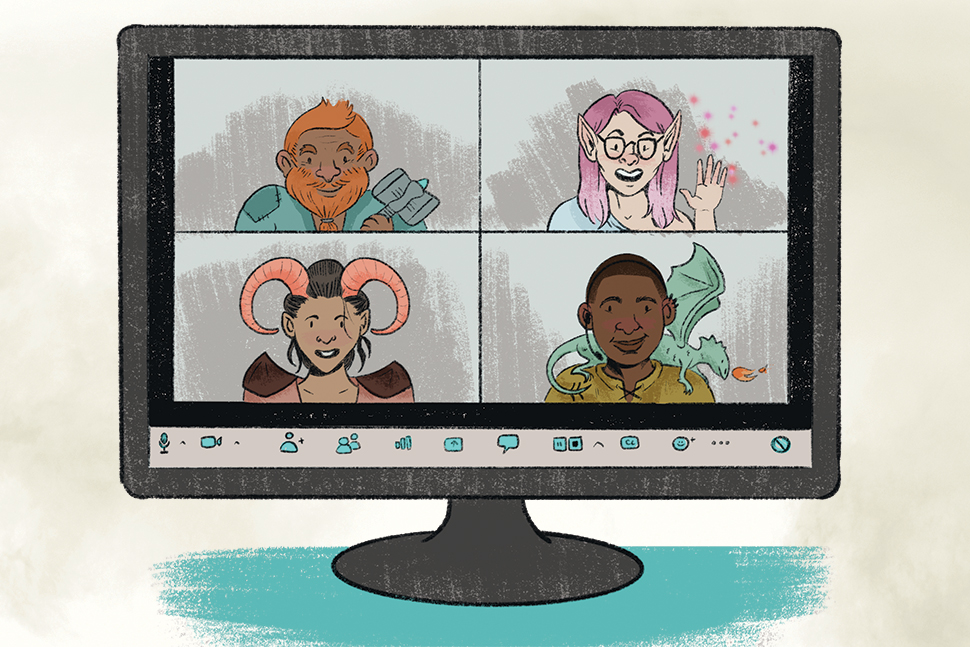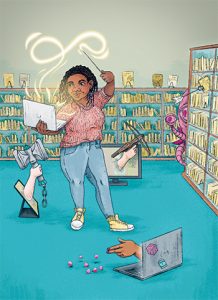
When you seek the advice of a goblin priest in the fantasy world of Dungeons & Dragons, beware: Instead of helping you in your quest, he might try to feed you to a tentacled monster with a taste for adventurers.
A crew of six explorers—library patrons playing as a gnome, two half-elves, two humans, and a wood elf—learned this lesson during their weekly online game, led by Greenfield (Mass.) Public Library (GPL) Assistant Jeremiah Rood.
Spoiler alert: The adventurers went on to slaughter the monster, as well as the campaign’s goblin king, before reaching the forgotten dwarf mine they were looking for, says Rood. As “dungeon master,” he guides the players and sets the parameters of the game.
Rood, who launched GPL’s program in June, joins a growing community of Dungeons & Dragons enthusiasts who are connecting through virtual library programs. Unlike libraries that transitioned their Dungeons & Dragons games from meetups at the library to online, Rood began holding virtual games during the pandemic as an inexpensive way to bring people together.
“I think what people miss in this time and what a library can offer is community,” he says. “I don’t think they need more stuff to do. They need more ways to interact.”
The dungeon is open
Librarians who run Dungeons & Dragons programs emphasize the low-cost nature of the game and others like it. Krista Hutley, teen and adult librarian at Wilmette (Ill.) Public Library (WPL), has been holding games on a weekly, rather than monthly, basis since the pandemic lockdowns began for a fraction of the usual expense, she says. That’s mainly because online gatherings don’t require her to buy food for the participants.
“My cost for Dungeons & Dragons in person was all pizza,” she says. “If you think about it, on average, I had 15 to 20 players once a month plus dungeon masters and myself—it was expensive. The games themselves were not.”
Librarians typically use some combination of Zoom, Google Hangouts, and Discord to communicate during the games; some also use the online gaming platform Roll20, which offers shared maps and other features. Librarians also might consider using the Discord bot Avrae to perform the often burdensome mathematical calculations that follow each roll of the dice.
Platform ease of use is among librarians’ top considerations, since games typically last between an hour and a half and three hours. After all, the more time you spend getting patrons logged in online, the less time everyone has to fight monsters.
Some librarians have made it even easier for patrons. Kathleen Uy, adult and teen librarian at White Oak Library (WOL) in Silver Spring, Maryland, uses the share-screen function on Zoom to display her Roll20 account, which makes it easier for participants to play the game. “I didn’t want patrons to have the added burden of having to create [their own] Roll20 accounts,” she says.
Mastering your domain
While Dungeons & Dragons’ low cost and popularity among teens make it an attractive program, librarians who are new to the game—particularly those who choose to serve as dungeon master—do face a learning curve.

Zoë DiGiorgio, library associate at Harford County (Md.) Public Library, says she had played Dungeons & Dragons only outside of work prior to becoming a dungeon master for the library. Even with her knowledge of the game, she describes leading an adventure as a learning experience.
“Becoming a dungeon master is tricky because there’s no one way to do it,” she says, noting the preparation it takes to learn the rules of the game.
She says the game can be a challenge to learn from an organizer’s perspective because you must understand the complex character sheets that define the players’ various traits. Dungeon masters also guide the narrative flow of the game, setting its pace and providing feedback to players.
That said, in some ways, operating in a digital environment is easier, she says. Working at a computer during the games allows her to quickly look up answers to players’ questions, and she’s found that younger kids are better behaved in the virtual world. “They know this environment now, and they’re really comfortable with it,” DiGiorgio says.
Libraries can also get their programs up and running online faster through collaboration with other libraries, she adds. Her library works with a staff member from another branch who serves as a game moderator—different from a dungeon master—and handles tech issues that arise during the games. “The moderator … can jump in and triage problems,” DiGiorgio says.
DiGiorgio advises finding a system that’s comfortable and suggests keeping notes explaining the process for later reference. She points out that it’s not hard to find blog posts and online videos that explain how to use Discord and other programs. “You don’t have to reinvent the wheel,” she says.
A new audience
Not only is Dungeons & Dragons attracting teens to the library, it’s also gaining the attention of younger middle-school students and adult patrons.
Arra Katona, teen services coordinator at Belmar Library in Lakewood, Colorado, says her library’s Dungeons & Dragons program was already in place prior to the pandemic, which made it easier to transition to an online environment. Its program has been so popular that the library holds two sessions every Saturday—one for beginning players and another for advanced.
The games at Belmar are for patrons ages 11–18, but one player participates with her father. Katona wouldn’t normally allow a parent to join but allows it in this case because he often coaches other players.
Meanwhile, WPL’s program is for grades 7–12. “I wanted to do that because our high school has a pretty big Dungeons & Dragons club that meets weekly,” Hutley says. She chose to include the high school age bracket to attract older students who could serve as dungeon masters. She also recruited adult volunteers—who underwent background checks—to help facilitate. Hutley ultimately created two groups, one for middle school kids and another for high school students, because of the games’ popularity.
She notes that her program uses Zoom and Roll20, which might be advanced for younger kids. “Roll20 is approved for ages 13 and up. It’s a little less protected [than other platforms],” she says. “For the younger kids, it can be too much technology for them to figure out.”
Uy, who shares WOL’s dungeon master duties with her husband, says that in her program, which she markets to middle school kids through adults, parents commonly play alongside their children. Uy says in her experience, kids under 10 or 11 years old don’t do as well with Dungeons & Dragons.
GPL’s program is available to anyone who wants to participate. Rood originally focused on older patrons in their 30s and 40s, promoting game nights to those who might have watched the popular Netflix series Stranger Things (which draws heavily on 1980s popular culture, including Dungeons & Dragons).
“I thought we’d target people who wouldn’t necessarily do this but might give it a shot; I thought we’d get bored dads, but instead we got moms,” he says, noting that all but one of his six regular players are women. Rood uses Google’s video chat platform for the games, but players use only the voice function, so they can’t see one another. “I couldn’t pick them out on the street; I know only their voices and the characters they’re playing,” he says.

The longstanding stereotype is that Dungeons & Dragons players are mostly white and mostly male. However, the five librarians who discussed their programs with American Libraries reported a more diverse array of participants. The beginner’s group in Colorado, for instance, is made up of mainly female players—only two of the eight are male.
Several sources say they were unaware of the racial makeup of their group’s players because many participate without appearing on video. Three of the five libraries reported that the majority of players are white with some Asian and Latinx players, while about a quarter of players at Harford County Public Library are Black or biracial. WPL’s program attracts an above-average number of LGBTQ+ teens.
What’s the endgame?
Librarians running Dungeons & Dragons games remotely attest to its ability to build community during this time of isolation. But the game offers more than just a social outlet. Math, storytelling, acting—players develop a variety of skills, says DiGiorgio. “They’re also learning teamwork, and they gain confidence; it’s a great fit for libraries,” she says. “It’s a good escape, but it’s also a good way to connect.”
Rood echoes that sentiment. “Personally, I have a 4-year-old who I love dearly, and a wife who I love dearly, but when Daddy goes down to the basement, it’s his time to play Dungeons & Dragons,” he says with a chuckle.
The games are also about personal connection. Hutley laments the departure of one participant, a student who is headed to college. “I’m so sad, because he’s written 100–200 pages of a campaign guide in that world [of Dungeons & Dragons]; he’s telling this incredible story,” she says. “It’s such a wonderful game, because you can use all kinds of creativity; you can tell any kind of story you want.”
For many, online role-playing games are a lifeline, says Uy, who hosts games on Saturdays and Sundays for WOL patrons. She gives up her weekends because “I know things are hard on people,” she says. “Some are totally alone and not with a quarantine family.”
Rood says his players never talk about the elephant in the room that has sickened and killed so many and put millions of people out of work: “These people don’t really talk about COVID-19 at all.”
On the best nights, he says, everyone is sitting around, trading stories, laughing, and having a great time. “If that isn’t a win in these difficult times, then I’m not really sure what is.


